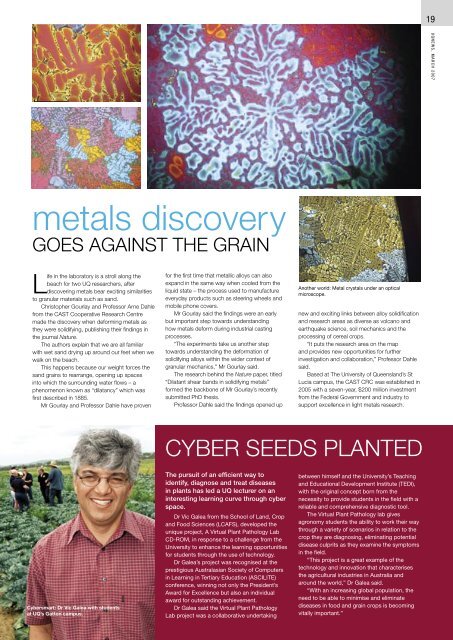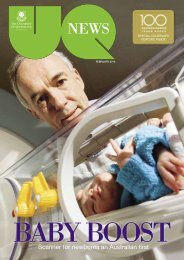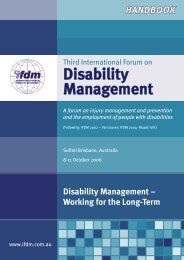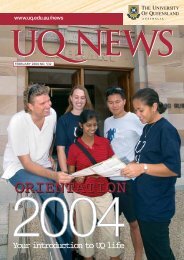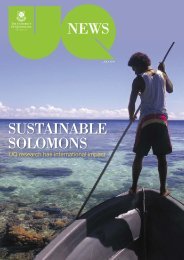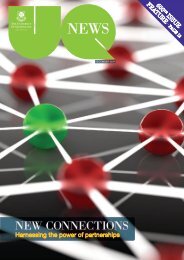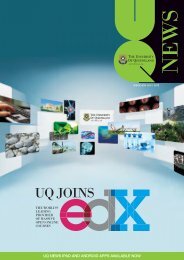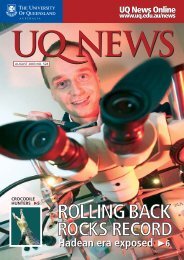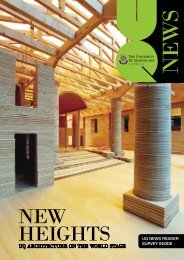Issue 562 (March 2007) - Office of Marketing and Communications
Issue 562 (March 2007) - Office of Marketing and Communications
Issue 562 (March 2007) - Office of Marketing and Communications
- No tags were found...
You also want an ePaper? Increase the reach of your titles
YUMPU automatically turns print PDFs into web optimized ePapers that Google loves.
19U Q N E W S , M A R C H 2 0 0 7metals discoveryGOES AGAINST THE GRAINLife in the laboratory is a stroll along thebeach for two UQ researchers, afterdiscovering metals bear exciting similaritiesto granular materials such as s<strong>and</strong>.Christopher Gourlay <strong>and</strong> Pr<strong>of</strong>essor Arne Dahlefrom the CAST Cooperative Research Centremade the discovery when deforming metals asthey were solidifying, publishing their findings inthe journal Nature.The authors explain that we are all familiarwith wet s<strong>and</strong> drying up around our feet when wewalk on the beach.This happens because our weight forces thes<strong>and</strong> grains to rearrange, opening up spacesinto which the surrounding water flows – aphenomenon known as “dilatancy” which wasfirst described in 1885.Mr Gourlay <strong>and</strong> Pr<strong>of</strong>essor Dahle have provenfor the first time that metallic alloys can alsoexp<strong>and</strong> in the same way when cooled from theliquid state – the process used to manufactureeveryday products such as steering wheels <strong>and</strong>mobile phone covers.Mr Gourlay said the findings were an earlybut important step towards underst<strong>and</strong>inghow metals deform during industrial castingprocesses.“The experiments take us another steptowards underst<strong>and</strong>ing the deformation <strong>of</strong>solidifying alloys within the wider context <strong>of</strong>granular mechanics,” Mr Gourlay said.The research behind the Nature paper, titled“Dilatant shear b<strong>and</strong>s in solidifying metals”formed the backbone <strong>of</strong> Mr Gourlay’s recentlysubmitted PhD thesis.Pr<strong>of</strong>essor Dahle said the findings opened upAnother world: Metal crystals under an opticalmicroscope.new <strong>and</strong> exciting links between alloy solidification<strong>and</strong> research areas as diverse as volcano <strong>and</strong>earthquake science, soil mechanics <strong>and</strong> theprocessing <strong>of</strong> cereal crops.“It puts the research area on the map<strong>and</strong> provides new opportunities for furtherinvestigation <strong>and</strong> collaboration,” Pr<strong>of</strong>essor Dahlesaid.Based at The University <strong>of</strong> Queensl<strong>and</strong>’s StLucia campus, the CAST CRC was established in2005 with a seven-year, $200 million investmentfrom the Federal Government <strong>and</strong> industry tosupport excellence in light metals research.CYBER SEEDS PLANTEDCybersmart: Dr Vic Galea with studentsat UQ’s Gatton campus.The pursuit <strong>of</strong> an efficient way toidentify, diagnose <strong>and</strong> treat diseasesin plants has led a UQ lecturer on aninteresting learning curve through cyberspace.Dr Vic Galea from the School <strong>of</strong> L<strong>and</strong>, Crop<strong>and</strong> Food Sciences (LCAFS), developed theunique project, A Virtual Plant Pathology LabCD-ROM, in response to a challenge from theUniversity to enhance the learning opportunitiesfor students through the use <strong>of</strong> technology.Dr Galea’s project was recognised at theprestigious Australasian Society <strong>of</strong> Computersin Learning in Tertiary Education (ASCILITE)conference, winning not only the President’sAward for Excellence but also an individualaward for outst<strong>and</strong>ing achievement.Dr Galea said the Virtual Plant PathologyLab project was a collaborative undertakingbetween himself <strong>and</strong> the University’s Teaching<strong>and</strong> Educational Development Institute (TEDI),with the original concept born from thenecessity to provide students in the field with areliable <strong>and</strong> comprehensive diagnostic tool.The Virtual Plant Pathology lab givesagronomy students the ability to work their waythrough a variety <strong>of</strong> scenarios in relation to thecrop they are diagnosing, eliminating potentialdisease culprits as they examine the symptomsin the field.“This project is a great example <strong>of</strong> thetechnology <strong>and</strong> innovation that characterisesthe agricultural industries in Australia <strong>and</strong>around the world,” Dr Galea said.“With an increasing global population, theneed to be able to minimise <strong>and</strong> eliminatediseases in food <strong>and</strong> grain crops is becomingvitally important.”


